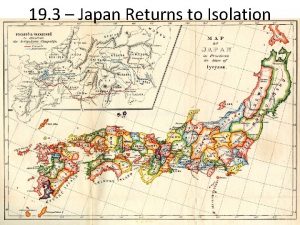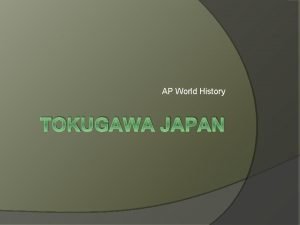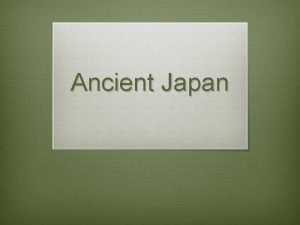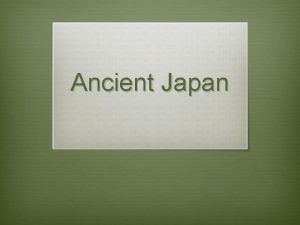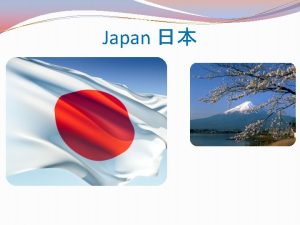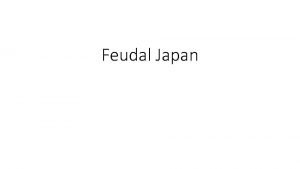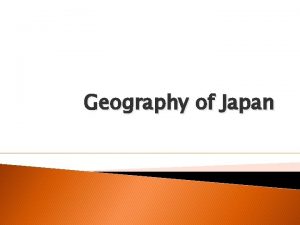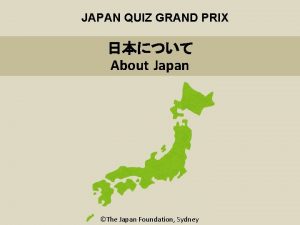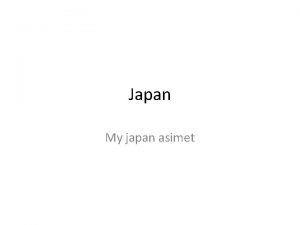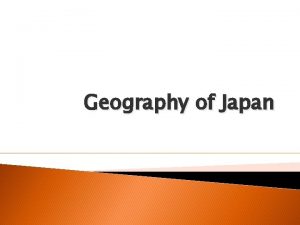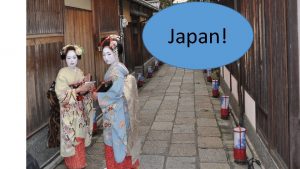World War II The War with Japan World


















- Slides: 18

World War II The War with Japan

World War II � Japan wanted to resurrect Hideyoshi Toyotomi’s dream of a Japanese empire. In addition, since Japan island nation, they lacked the necessary raw materials to achieve their goal. � Japan’s first moves were against the Asian mainland. Japan had annexed Korea in 1910. � In 1931 Japanese troops occupied Manchuria, bringing that region’s resources under Japanese control.

World War II � Hitler’s moves against Britain, France, and the Netherlands gave Japan new chances to expand into the Pacific. � These European countries had to leave their Pacific colonies undefended to fight against Hitler. � Japan planned to add these lands to its possessions on the mainland. These colonies would provide Japan with oil, rubber, and tin for Japanese industry, rice for Japanese people, and markets for Japanese products.

World War II � Only the United States was strong enough to challenge Japanese expansion. � The United States began to limit trade with Japan and imposing an embargo—a ban—on the sale of vital raw material to that country. � Convinced that war with the United States was coming, Japan allied itself with the Axis Powers. � Japanese leaders also began planning a massive surprise attack on the United States.

World War II � Early on the morning of December 7, 1941, Japanese planes took off from aircraft carriers to attack Pearl Harbor, the American naval base in the Hawaiian Islands. � The warships in the harbor and the planes lined up along the runways were easy targets for the low-flying Japanese bombers. � The attack destroyed much of the United States’ Pacific fleet and air force. � Japan also attacked other American island bases in the Pacific.

World War II � By 1942, the Japanese had taken the Philippines, Burma and Singapore. They also conquered the Dutch East Indies, French Indochina, and other territories in Southeast Asia and the Pacific. � The Japanese treated conquered Asian peoples harshly. For example, in 1937, Japan attacked China, unleashing a brutal war of conquest. � During the infamous Rape of Nanking, a Chinese city, over 250, 000 Chinese perished, including 20, 000 women, who were raped, tortured, and then executed. � Japanese soldiers admitted that their fellow soldiers impaled babies on bayonets and tossed them still alive into pots of boiling water.

World War II � Under Japanese rule, thousands of Asian laborers and Dutch, Australian and British prisoners of war were forced to build railways and roads through mountains and jungles. � Bitter about Japanese exploitation, the conquered people carried out guerrilla warfare against the Japanese. � By the Spring of 1942, the United States had begun to rebuild its Pacific forces and were ready to fight.

World War II � Both the United States and Japan faced each other at Midway, an isolated island about 1, 000 miles northwest of Pearl Harbor. � After a long hard battle, the American forces defeated the Japanese at the Battle of Midway. � Nearly all of the United States fighter planes were shot down during Midway but the Japanese lost their four best aircraft carriers, along with the planes on deck and many skilled pilots.

World War II � After Midway, the war in the Pacific turned in favor of the United States. � The United States plan was to push Japan out of the islands. The Allied forces would seize only those islands that were in strategic positions on the sea route to Japan. � The early campaigns were slow as the allied forces had to engage the Japanese in jungle warfare.

World War II � Casualties ran high in the Pacific because of the fierce determination of the Japanese. Infantry soldiers fought to the death rather than be taken prisoner. � Kamikaze pilots deliberately crashed their planes into American ships. � In the battle for Iwo Jima it took the American Marines three days to gain 700 yards. � In a month of fighting, more than 5, 000 Americans were killed another 15, 000 were wounded.

World War II � Casualties were even higher at Okinawa, the last battle in the Pacific war. � The number killed there added up to about 12, 500 Americans, 120, 000 Japanese and 42, 000 Okinawans. � Harry Truman who became President after Roosevelt died, hoped to avoid a costly invasion of Japan. � He chose to use America’s secret weapon: the atomic bomb

World War II � On August 6, 1945, a single atomic bomb was dropped on the Japanese city of Hiroshima. � The world was stunned at the destructive power of the new weapon. � The bomb completely demolished about 60% of Hiroshima. For four miles around the target point, almost no building were left standing. � More than 80, 000 people were killed and 37, 000 more suffered severe injuries. Others died later from the after effects of radiation poisoning.

World War II

World War II

World War II

World War II

World War II

World War II � Japan did not surrender after the dropping of the first bomb, so the United States dropped another on Nagasaki. Again the effects were deadly. � Emperor Hirohito forced the military to surrender for the good of the country. � On August 15, the emperor announced the defeat to his people. � On September 2, officials of the Japanese government signed the document of surrender on board the battleship Missouri in Tokyo Bay. � The war against Japan was over and World War II came to a close.
 Japan civil war 1467
Japan civil war 1467 Stella theodoulou
Stella theodoulou Hát kết hợp bộ gõ cơ thể
Hát kết hợp bộ gõ cơ thể Slidetodoc
Slidetodoc Bổ thể
Bổ thể Tỉ lệ cơ thể trẻ em
Tỉ lệ cơ thể trẻ em Voi kéo gỗ như thế nào
Voi kéo gỗ như thế nào Thang điểm glasgow
Thang điểm glasgow Alleluia hat len nguoi oi
Alleluia hat len nguoi oi Môn thể thao bắt đầu bằng chữ đua
Môn thể thao bắt đầu bằng chữ đua Thế nào là hệ số cao nhất
Thế nào là hệ số cao nhất Các châu lục và đại dương trên thế giới
Các châu lục và đại dương trên thế giới Công thức tính thế năng
Công thức tính thế năng Trời xanh đây là của chúng ta thể thơ
Trời xanh đây là của chúng ta thể thơ Cách giải mật thư tọa độ
Cách giải mật thư tọa độ Làm thế nào để 102-1=99
Làm thế nào để 102-1=99 Phản ứng thế ankan
Phản ứng thế ankan Các châu lục và đại dương trên thế giới
Các châu lục và đại dương trên thế giới Thơ thất ngôn tứ tuyệt đường luật
Thơ thất ngôn tứ tuyệt đường luật
